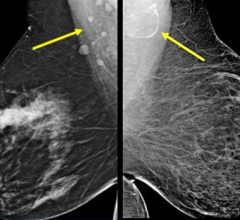
Greg Freiherr has reported on developments in radiology since 1983. He runs the consulting service, The Freiherr Group.
Mammography’s Looming Dose War
By Greg Freiherr
As the dose wars in computed tomography (CT) draw to a close, a new one approaches, this one in mammography. The surprise should not be that this war is coming, but that it is taking so long to get here.
Mammography is the only imaging exam widely performed to screen apparently healthy people. It exposes them to ionizing radiation that, if administered in substantial quantities, can cause the very disease for which they are being screened. And it does so not once or twice, but annually for 30 or more years, per guidelines developed by the American Cancer Society (http://www.cancer.org/Healthy/FindCancerEarly/CancerScreeningGuidelines/american-cancer-society-guidelines-for-the-early-detection-of-cancer), with the understanding that the risk of cancer from radiation exposure increases with cumulative dose.
Yet, in the past, when questions about the benefit of such repetitive screening were raised, they were immediately and soundly rebuked by women’s health leaders who defended screening as a major, if not the primary, reason for declining deaths due to breast cancer. Then why now do I believe dose will become an issue? Because the technology to reduce dose is finally available in the United States – and being aggressively marketed on its ability to significantly cut patient radiation dose.
This product – Philips’ Microdose mammography product – like so much about mammography and radiation dose, is steeped in irony. It is not new. It has been sold for years in Europe. But Microdose entered the U.S. only this fall after Philips Healthcare acquired Sectra’s mammography modality business operations.
Three months after this deal was final, during the RSNA annual meeting in November, the ability of this product to cut patient radiation dose was ballyhooed on the exhibit floor of the McCormick Center, on television, even on the sides of buses ferrying radiologists to and from the meeting. The message was inescapable. And it will become so again in the year ahead.
Much like what happened in CT, all the vendors of mammography equipment will have to climb onboard this bandwagon and they will have to do so quickly. They cannot cede the high ground of digital mammography to newcomer Philips, nor can they risk appearing unsympathetic to concerns about radiation dose, when tens of millions of American women undergo mammography every year.
With this, we can expect a new vernacular for the modality, one reliant on the use of “low,” “optimized,” “minimum” and “efficient” as descriptors of dose administered by mammography equipment. Vendors will use several, possibly all, these descriptors in the same paragraph, if not the same sentence to define their products.
When that happens, it will be a sure sign that this new war has begun.


 May 10, 2024
May 10, 2024 








